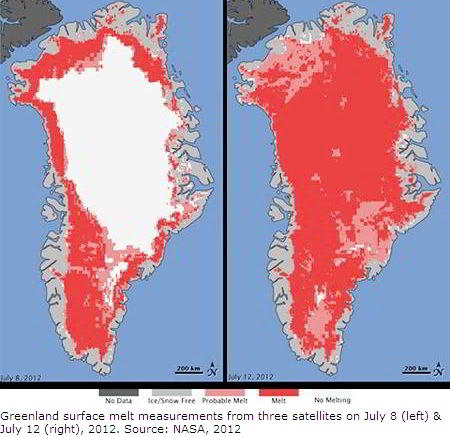 Washington – The world is barrelling down a path to heat up by 4 degrees at the end of the century if the global community fails to act on climate change, triggering a cascade of cataclysmic changes that include extreme heatwaves, declining global food stocks, and a sea-level rise affecting hundreds of millions of people, according to a new scientific report released on November 19 that was commissioned by the World Bank.
Washington – The world is barrelling down a path to heat up by 4 degrees at the end of the century if the global community fails to act on climate change, triggering a cascade of cataclysmic changes that include extreme heatwaves, declining global food stocks, and a sea-level rise affecting hundreds of millions of people, according to a new scientific report released on November 19 that was commissioned by the World Bank.
All regions of the world would suffer – some more than others – but the report finds that the poor will suffer the most.
“Turn Down the Heat”, a snapshot of the latest climate science prepared for the World Bank by the Potsdam Institute for Climate Impact Research (PIK) and Climate Analytics, says that the world is on a path to a 4 degree Celsius [1] (4°C) warmer world by end of this century and current greenhouse gas emissions pledges will not reduce this by much.
“A 4 degree warmer world can, and must be, avoided – we need to hold warming below 2 degrees,” said World Bank Group President Jim Yong Kim. “Lack of action on climate change threatens to make the world our children inherit a completely different world than we are living in today. Climate change is one of the single biggest challenges facing development, and we need to assume the moral responsibility to take action on behalf of future generations, especially the poorest.”
The report says that the 4°C scenarios are potentially devastating: the inundation of coastal cities; increasing risks for food production potentially leading to higher under and malnutrition rates; many dry regions becoming dryer, wet regions wetter; unprecedented heat waves in many regions, especially in the tropics; substantially exacerbated water scarcity in many regions; increased intensity of tropical cyclones; and irreversible loss of biodiversity, including coral reef systems.
“The Earth system’s responses to climate change appear to be non-linear,” points out PIK Director, John Schellnhuber. “If we venture far beyond the 2 degrees guardrail, towards the 4 degrees line, the risk of crossing tipping points rises sharply. The only way to avoid this is to break the business-as-usual pattern of production and consumption.”
The report notes, however, that a 4°C world is not inevitable and that with sustained policy action warming can still be held below 2°C, which is the goal adopted by the international community and one that already brings some serious damages and risks to the environment and human populations.
“The world must tackle the problem of climate change more aggressively,” Kim said. “Greater adaptation and mitigation efforts are essential and solutions exist. We need a global response equal to the scale of the climate problem, a response that puts us on a new path of climate smart development and shared prosperity. But time is very short.”
The World Bank Group’s work on inclusive green growth has found that with more efficient and smarter use of energy and natural resources opportunities exist to drastically reduce the climate impact of development without slowing poverty alleviation or economic growth.
“While every country will take a different pathway to greener growth and balance their own need for energy access with energy sustainability, every country has green growth opportunities to exploit,” said Rachel Kyte, World Bank Vice President for Sustainable Development.
Those initiatives could include: putting the more than US $ 1 trillion of fossil fuel and other harmful subsidies to better use; introducing natural capital accounting into national accounts; expanding both public and private expenditures on green infrastructure able to withstand extreme weather and urban public transport systems designed to minimize carbon emission and maximize access to jobs and services; supporting carbon pricing and international and national emissions trading schemes; and increasing energy efficiency – especially in buildings – and the share of renewable power produced.
“This report reinforces the reality that today’s climate volatility affects everything we do,” Kyte said. “We will redouble our efforts to build adaptive capacity and resilience, as well as find solutions to the climate challenge.”
Turn Down the Heat: Why a 4°C Warmer World Must be Avoided summarizes a range of the direct and indirect climatic consequences under the current global path for greenhouse gas emissions.
- Rising Sea Levels
The report says sea levels have been rising faster in the last two decades than previously, and this rise is being seen in many tropical regions of the world. This phenomenon is partly due to melting of the Greenland and Antarctic ice sheets; the rapid growth in melt area observed since the 1970s in Greenland’s ice sheet is a clear illustration of its increasing vulnerability. Arctic sea ice also reached a record minimum in September 2012. “There are indications that the greatest melt extent in the past 225 years has occurred in the last decade,” says the report.


















